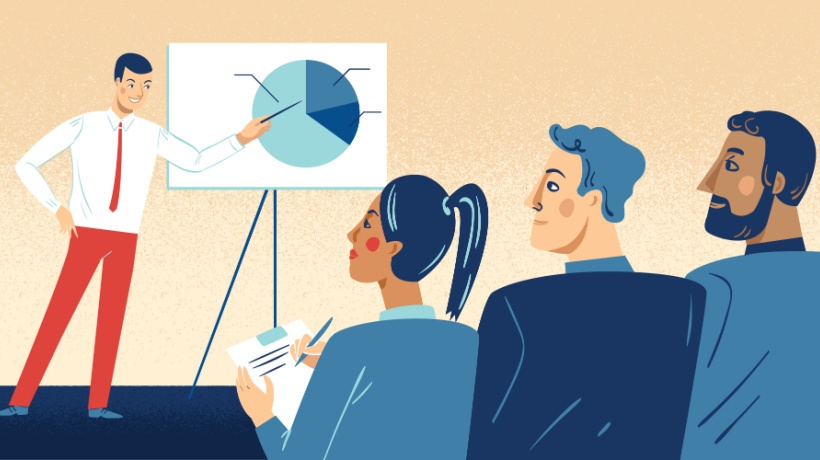The Short And Sweet
Entertain. Educate. Review. In that order.
Some of the greatest trainers do just that. This is something I started doing after I learned about sales.
Note to you, the reader: If you only had 2 seconds and you’re leaving now, thank you come again. If you have 2 - 5 minutes, it's STORY TIME!
Storytime
As a salesman in my early 20s, I had to learn how to “entertain, educate, and close” pretty quickly. Let me take you back to my first day at my favorite sales job. It was a brisk and damp Monday morning. I walked into the office bright and early after training the day before, ready to seize the day. At the morning meeting, I kept hearing about going out into “the field” several times with my new crew. We also discussed weekly quotas and who would be the team leaders. Up to this point, we had rehearsed the sales script on what to say to people when we approached them while we were in the office. I had even rehearsed the script by myself the night before. However, I still didn’t have any idea of what was in store when I went out into “the field.” As the morning met the afternoon, it was time to suit up and go out into “the field” to put our skills to the test.
My team and I walked out into what was still a gloomy Monday. The sidewalks were filled with people in suits and fancy shoes. The streets were filled with people in buses, cabs, and cars. I was eagerly awaiting this field I kept hearing about. The conversation between my team members was casual and seemed familiar...to them. We walked about 7 blocks. Took the red line on the metro. Walked up the escalator to the street and stood in front of a Panera Bread. Didn’t look like a field to me, so I asked, “What are we doing here?” My trainer said, “Welcome to the field. Just start waving at people. Don’t worry about talking until you get comfortable.” I thought, “Oookay,” and did just that. I waved at people and watched my teammates work their magic.
As people walked toward us from all directions or as we stood in their way (however you want to look at it), most people were looking at their phones. I know, shocking. Then, I heard my teammates saying, “Hey, you can stop texting me now, I’m right here." "Hey can I ask you a question?” People began to stop and laugh or become curious. Then, my teammates began to educate. I sat back and watched in awe as people stopped what they were doing to listen to my teammates and laugh and learn about the children who needed sponsorship around the world for better education, housing and more, on the middle of the sidewalk. What was even more surprising is that complete strangers were willing to give their credit card numbers up to people who were complete strangers 10-20 minutes ago, based on that entertainment, education, and closing. It worked like magic. I became very intrigued, especially because I was a tutor at the time and learning about the best learning theories and methods to teach on and offline. In real time, I was looking at something that would work anywhere.
Eventually, I learned how to work my own magic and incorporated it into my teaching with amazing results. I taught both online and offline, so I was able to test it in both environments. Now, here is how you can convert that same magic into your own eLearning.
The Avocado And Potatoes
Entertain
Whether people are walking down the street on their phones or logging onto your Learning Management System, more than likely, they are not in the mood to learn. However, people are almost always in the mood to be entertained. In his book, Caught in Play: How Entertainment Works On You, Peter G. Stromberg talks about a concept he calls Romantic Realism. Romantic realism basically describes how we gravitate toward fictional realities that are a little better than our own mundane lives. This is what people are looking for. Give it to them. Social media is rampant with people using entertainment to get their messages across. It works.
Educate
Now for the education part. This isn’t a time to just throw information at people. Don’t do that. This is a time to create lasting connections in a person’s brain that will translate into behavior change, awareness, or whatever else your ultimate goal is. Though this is technically the “educate” subtitle, entertainment is still needed here, but at the right moments. Entertainment is especially helpful during moments you can tell your learners are experiencing a great bit of cognitive load or information overload. In other words, when you're giving them TMI.
Review
This is the time to reiterate what you have already taught and test your learner’s skills. This is when your learners can recall information and tell their brain, "Hey, here this information is again. It must be IMPORTANT!"
Shoutout to Billy Gene from Billy Gene is Marketing for the name inspiration with his, Entertain, Educate, Execute method. When creating eLearning, make it relevant and fun. The purpose of this is to tell the person’s brain that this information is relevant to their life and make sure they can recall the information and incorporate it into their behavior going forward.
Entertain, Educate, and Review is something I’ve done many times in sales and in teaching that can make your eLearning something people look forward to, rather than something that people feel like they have to get through.










